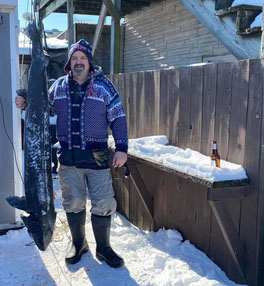Lake Winnebago home to robust sturgeon population
April 22, 2020
It’s not likely to be mistaken as Jaws. But it’s a big — make that huge — fish with a long history that gets people excited. And it just happens to make Lake Winnebago its home.
In fact, Lake Winnebago has one of the largest, most robust lake sturgeon populations in the world. First appearing about 136 million years ago when dinosaurs still roamed the earth, sturgeon can weigh 100 or more pounds and live up to 100-150 years.
Additionally, the Winnebago System is one of the few places where you can see this fish up close as it spawns on shallow shorelines, usually in mid- to late-April. It’s also one of the few places where, each February, you can try to spear one of these bottom dwellers.
The first sturgeon spearing season on Lake Winnebago began in the winter of 1931-1932, but that tradition continues annually as fishermen from across the state and Midwest gather on Lake Winnebago each winter in hopes of spearing one of these prehistoric creatures.
Anglers sit in a darkened shanty, staring into a hole cut into the ice, and wait for a sturgeon to swim up to their sturgeon decoy below. And when — make that if — one does and it is at least the required 36-inches in length — they throw a spear at it and hope their aim is accurate.

A harvest cap was not met during the 2020 sturgeon spearing season on the Winnebago System, meaning the season was able to last the full 16 days from Feb. 8-23. A total of 811 sturgeon were harvested during the season — an increase of 12 fish harvested from the year before — with the largest being 171 pounds and 85.5 inches in length.
A mild winter presented problems for fishermen hoping to harvest a sturgeon as ice conditions were not ideal for car or truck travel, which stopped many fishermen from venturing out onto the ice in 2020.
Eric Nygaard, an Oshkosh resident and UW Oshkosh alumnus, says he was able to find safe ice during the spearing season with thickness ranging from 14” the first weekend to 19” the final weekend when he speared his 75.5-inch, 109-pound sturgeon.
Ryan Koenigs, Winnebago System sturgeon biologist for the Wisconsin Department of Natural Resources, explains the difference in fishermen on opening day in 2019 compared to opening day in 2020.
“We do aerial shanty counts on opening day that estimate the amount of effort that’s actually out on Lake Winnebago, and our shanty counts for opening day 2020 were down about 45% from what they were on opening day of the 2019 spearing season, and that’s pretty consistent sales,” he said.

The mild winter and melting snow and ice affected the water’s clarity, which is crucial when spearing a sturgeon.
“Water clarity for the season on Lake Winnebago was pretty variable as well,” Koenigs said. “At the beginning of the season, I’d say it was pretty poor. A lot of what I was hearing was anecdotal information from spearers who were out scouting and they said they could see 7-10 feet down in some areas…”
Greg Schwarz, a local fisherman, says he was able to see 10-feet to 12-feet on Lake Winnebago when he speared his
67.1” long and 85.5 pound sturgeon in February.
The seasons that did see the most success were during the 1990s when water clarity started improving.














